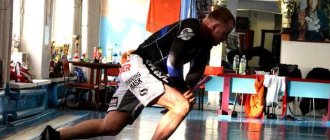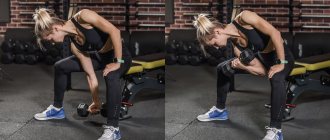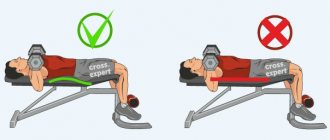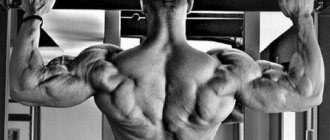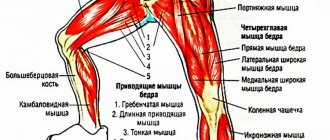The ability to concentrate on an activity for a long time depends largely on the brain, but what comes into play when it comes to physical activity? Yes, this is sports endurance. And it is born not from downloading a sports application on your phone, but from long-term complex training over a long time.
This is the same superpower that allows you not only not to get tired, but also to develop the main element of a person’s healthy life - the level of his physical activity. But what the body’s endurance depends on, how to develop it and what to pay attention to will be discussed in the article.
What is endurance?
First, let's figure out what endurance is and what it is eaten with. Endurance is a physical quality that characterizes the ability to perform physical work for a long time without reducing its effectiveness. Roughly speaking, if you can climb to the tenth floor of a house without shortness of breath and without your pulse pounding in your temples, congratulations, you are quite resilient. If after a couple of floors you stop to catch your breath, then, alas, you need to train and train.
Exercise tests to study aerobic capacity
Load tests are simulations of real muscle work in a laboratory environment. When conducting such studies, it is important to choose the right test based on which muscle groups the athlete uses in real conditions. The tests measure physiological responses under various loads.
The main purpose of stress tests is to monitor changes in various physiological indicators under loads of different intensities, including maximum loads.
Two types of stamina
However, there are two types of endurance: general body endurance and special . The general one is manifested in the fitness of the cardiovascular, respiratory and nervous systems of the body. The example was given above - if you are out of breath and tired after climbing several floors or after jogging a hundred meters, then your overall endurance is poor. In general, general endurance is demonstrated by cardio activities such as running, swimming, walking, and cycling. The second type of endurance - special - is manifested in specific exercises characteristic of a particular type of activity. Pulling up for a long time, lifting a barbell, jumping, boxing, throwing a ball into a basket - all this speaks of the athlete’s excellent special endurance.
Do not think that weight training, such as bodybuilding or powerlifting, does not develop endurance to any degree; this is not true. When practicing these sports, special endurance develops and it significantly trains the cardiovascular, respiratory and nervous systems. Only a certain level of development of all these systems allows an athlete to progress in muscle mass and strength. General endurance training just makes it better. What prevents you from combining them for better effect? HIIT can be called one of the successful examples of combining these types of endurance.
When you have sorted out the types of endurance, you can move directly to what develops it.
The world's toughest athletes
Based on the example of great athletes who achieved unprecedented heights, having mediocre physical data, it can be argued that human endurance goals can reach any level.
Adrian Solano
His long path in the sport went through the list of outsiders; he had never skied or practiced on snow before. At the World Ski Championships he was included in the list of the worst skiers on the planet. Literally, he fell and rose in every competition. But not only was he not upset by the failures, but he also increased the duration and frequency of his training.
Now the athlete provides charitable assistance to athletes. He is known throughout the world as one of the toughest men in the world of sports.
Pita Tuatofua
The famous taekwondo player Pita tried his hand at cross-country skiing many times. At the World Championships he took 153rd place out of 156. His performance at the Olympics was also unsuccessful for him. But an example of the fact that genes do not always play a role, giving way to focus and strength of character, is brought to us by Tuatofua.
Now spectators and sports fans specifically buy tickets to the island of Tonga just to watch the famous athlete.
Morning and evening jogging: when to train, pros and cons
How to develop endurance?
Walking
The most accessible and free cardio exercise for a person to improve overall endurance is also the first stage of running. To walk, it is enough to have a tracksuit, regular sneakers and a desire to exercise. You should start walking slowly, gradually increasing the speed of your step, bringing it to a fast walk, which is about 6-7 kilometers per hour. You need to stay at this pace for half an hour or more, then gradually reduce your pace. If your heart is pounding and you are out of breath at a speed of 6 km/h, then the load is too high for you, try to reduce it. You can increase the load by increasing the upward angle. Walking can be done every other day.
Run
Running is the most common exercise for developing endurance, but in no case should you suddenly start running. You should start gradually, with fast walking, and only then move on to jogging, and then to a faster pace. For running you will need special running shoes. If you run in unsuitable shoes, this can lead to ankle and knee injuries. It is important to note that running for overweight people can lead to knee and spine injuries. In this case, running will not be beneficial, and it is better to limit yourself to brisk walking. It is recommended to run at least twice a week, or every other day. The duration of one running session is approximately 30-40 minutes, but you can gradually increase the time. An analogue of running is a treadmill in a sports club.
Swimming
Most likely, this is a set of movements to develop general endurance. A huge advantage is that when swimming, the musculoskeletal system is unloaded, and your spine will rest. This is suitable for overweight people. Plus, swimming burns more calories than other types of cardio exercise. You can swim in any style and at any speed, as long as you keep your breathing even and don't swallow water. It is recommended to swim at least twice a week for an hour.
Bike
Great for overweight people, as it relieves stress on the knees and spine. The main disadvantage is the cost of the bike itself. To develop endurance, it is recommended to do at least two bike rides per week. An analogue of a bicycle is an exercise bike in a fitness club.
Squats
An exercise familiar to us since school days. I believe that the vast majority of schoolchildren in physical education were forced to do a number of squats in order to get a high score in the diary. At home, you can squat a little, without additional weights, without particularly worrying about the position of the spine. Squat as many times as you can, but try to do it as technically and deeply as possible. If you master 50 squats, then great, each time you can increase the number of repetitions, bringing it to huge numbers. With a barbell, you will have to learn the correct technique and hold your body correctly, which, naturally, is more difficult. It will be more difficult to squat a number of times, since in addition to the legs, the upper half of the body, on which the barbell rests, will also be involved. Several sets of squats 20 times will exhaust you greatly, you should not repeat this more than once or twice a week, give yourself time to recover.
Jump rope
It is enough to purchase a jump rope and jump continuously at home for 10-15 minutes, gradually increasing the time. Jumping rope develops coordination well and burns calories. You can jump every other day or depending on how you feel.
Pushups
If you are strong enough, you can try push-ups. Girls can do push-ups on the floor while on their knees to reduce the load. It is important to monitor your breathing - when squeezing the body, you need to exhale, when lowering, inhale. Your task is to do several sets of push-ups. If you complete 20 reps in the first approach, then great. Try to increase the number of push-ups in all approaches to 20 times, but you can try to do one approach for the maximum number of times, several times a day. For example, try doing one set of push-ups in the morning and the same amount in the evening.
Jumping in place
Jumping in place with all kinds of leg lunges and arm raises will also help improve endurance. Very similar to aerobics for girls. Despite its apparent simplicity, holding on for even 10 minutes can be difficult.
Elliptical trainer
An excellent tool for developing overall endurance and burning calories. The disadvantage of such a simulator is its cost when it comes to home use. But you can find such exercise machines in fitness clubs. One session of classes should last half an hour or more.
Contraindications to classes
Aerobic endurance is an indicator that most healthy people can work on.
There are a number of contraindications to training:
- diseases of the cardiovascular system;
- bronchial asthma;
- severe mental disorders;
- chronic course of many diseases.
If you have any doubts, before starting intensive training, it is better to consult not only with a professional trainer, but also with a doctor, having undergone the necessary examinations to exclude contraindications.
Sources[edit | edit code]
- Schmidtbleicher, D., et al. 2014. Long-term strength training effects on change-of-direction sprint performance. Journal of Strength and Conditioning Research 28(1): 223-31.
- Atha, J. 1984. Strengthening muscle. Exercise and Sport Sciences Reviews 9:1-73.
- Dudley, G. A., and Fleck, S. J. 1987. Strength and endurance training: Are they mutually exclusive? Sports Medicine 4:79–85.
- Hickson, R. C., Dvorak, B. A., Corostiaga, T. T., and Foster, C. 1988. Strength training and performance in endurance-trained subjects. Medicine and Science in Sports and Exercise 20 (2) (Suppl.): 586.
- MacDougall, J. D., Tuxen, D., Sale, D. G., Moroz, J. R., and Sutton, J. R. 1985. Arterial blood pressure response to heavy resistance exercise. Journal of Applied Physiology 58(3): 785-90.
- Micheli, L. J. 1988. Strength training in the young athlete. In Competitive sports for children and youth, ed. E. W. Brown and C. E. Branta, 99-105. Champaign, IL: Human Kinetics.
- Nelson, A.G., Arnall, D.A., Loy, S.F., Silvester, L.J., and Conlee, R.K. 1990. Consequences of combining strength and endurance training regimens. Physical Therapy 70 (5): 287-94.
- Sale, D. G., MacDougall, J. D., Jakobs, I., and Garner, S. 1990. Interaction between concurrent strength and endurance training. Journal of Applied Physiology 68 (1): 260-70. Saltin, B. 1973. Metabolic fundamentals in exercise. Medicine and Science in Sports 5:137-46.
- Hoff, J., Gran, A., and Helgerud, J. 2002. Maximum strength training improves aerobic endurance performance. Scandinavian Journal of Medicine and Science in Sports 12 (5): 288-95.
- Ronnestad, B. R., and Mujika, I. 2013. Optimizing strength training for running and cycling endurance performance: A review. Scandinavian Journal of Medicine and Science in Sports. 24(4):603-6l2.
- Weyand, P. G., et al. 2000. Faster top running speeds are achieved with greater ground forces, not more rapid leg movements. Journal of Applied Physiology 89(5): 1991-99
- Kyrolainen, H., et al. 2001. Biomechanical factors affecting the running economy. Medicine and Science in Sports and Exercise 33 (8): 1330-37.
- Belli, A., et al. 2002. Moment and power of lower limb joints in running. International Journal of Sports Medicine 23(2): 136-41.
- Nummela, A., et al. 2007. Factors related to top running speed and economy. International Journal of Sports Medicine 28 (8): 655-61.
- Brughelli, M., et al. 2011. Effects of running velocity on running kinetics and kinematics. Journal of Strength and Conditioning Research 25(4): 933-39. doi:10.1519/JSC.0b013e3181c64308.
- Morin, J.B., et al. 2012. Mechanical determinants of 100-m sprint running performance. European Journal of Applied Physiology 112(11): 3921-30. doi:10.1007/s00421-012-2379-8.
- Kawamori, N., et al. 2013. Relationships between ground reaction impulse and sprint acceleration performance in team sport athletes./omgia/ of Strength and Conditioning Research 27 (3): 568-73. doi:10.1519/ JSC.0b013e318257805a.
- Hay, JG 1993. The biomechanics of sports techniques. Englewood Cliffs, NJ: Prentice Hall.
Why develop and methods of development
The task of improving aerobic endurance is not an end in itself, but an important condition for good health, a full and long life. To develop it, you can use a variety of physical exercises: athletics, gymnastics, cyclic, gaming, etc.
But they have general requirements:
- several major muscle groups must be involved at the same time;
- The training duration should be up to 60-90 minutes;
- exercises should be performed at moderate to high intensity.
Gym
The most popular place for men to work out. If you want to become strong and beautiful as quickly as possible, this is the place for you, because in terms of the ratio of effort expended to the result, here is optimal. Perhaps this is the most universal option: here you can become more beautiful, stronger, lose excess weight, develop your heart and much more. But you cannot embrace the immensity, and you will have to focus on one thing in order to achieve tangible results.
By and large, the gym represents two sports: bodybuilding and powerlifting, which are responsible for beauty and strength, respectively. In practice, most people do something in between (I call it athleticism).
The typical gym person can look different. It all depends on nutrition and training format.
Typical powerlifters
Typical bodybuilder
How does this affect life?
What can a “rocking chair” give to the average person?
A feeling of strength and self-confidence, an attractive figure, strong bones and healthy posture. You will discover a whole new world of equipment, exercises, training programs, techniques, nutritional supplements, diets and much more. It is very interesting to understand all this, but it is even more interesting to observe what results this knowledge gives (of course, with diligence). And after training, you will experience a pleasant feeling of fatigue in your muscles and relaxation throughout your body. But it is important to understand that if you want to achieve more or less impressive results (both in terms of beauty and strength), you need to take the issue of nutrition very seriously. Eating pizza, burgers, shortcakes with mayonnaise and other junk food, you will not be able to see under the fat the very muscles for which so much effort is spent and so much sweat is shed. On the other hand, without receiving enough calories and nutrients, the muscles will have nothing to grow from.
This is what a typical gym workout looks like for most visitors:
Pros:
- muscles will grow very quickly;
- versatility: you can develop strength, appearance, and endurance;
- building the body of your dreams is a very exciting activity;
- accessibility: there are fitness clubs and gyms in almost every city.
Minuses:
- despite the huge number of exercises, equipment and equipment, over time, training begins to seem monotonous and boring;
- a subscription costs money;
- Injuries may occur when working with heavy weights.
Gym training is right for you if:
- First of all, you want to get excellent appearance and (or) strength from exercise. And quickly.
- you have never worked with hardware before and want to be taught how to do it correctly
Advanced level
Endurance is an important aerobic characteristic that has certain limits. The advanced level implies that the athlete has achieved the desired physical condition and condition, and his goal, by and large, is to maintain performance and, if possible, improve it.
Burpee exercise diagram for aerobic endurance training
For an advanced level, all the above exercises are suitable, which can be made more complex, including by increasing the pace and duration of the workout.
A trained person, unlike a beginner, is able to perform more complex exercises:
- Burpee. Place your feet shoulder-width apart and squat as low as possible. Place your palms on the floor and jump into plank pose with your arms outstretched. Jump forward, pulling your legs towards your chest. Shift your body weight to your feet, jump up with a jerk, raising your arms.
- Climber . Stand in a horizontal plank position with your arms outstretched. Alternately pull your legs towards your shoulders while jumping, gradually increasing the pace.
- Jumping with lunges. Stand straight, feet shoulder-width apart, hands on your waist. Step forward into a lunge, with your knee forming a right angle. Change legs while jumping.
Construction of aerobic training, rules, principles
Any aerobic workout should consist of three stages: warm-up, main load and cool-down. Each of these stages is important and cannot be excluded from the training process, with the exception of cases of overwork or excessive fatigue, which usually occurs in a poorly prepared person or with incorrectly calculated loads.
| Training stage | Description |
| Warm-up | Warming up ensures gradual metabolic adaptation, prepares the respiratory and cardiovascular systems for subsequent work, prevents premature accumulation of lactic acid, and warms up the muscles to protect against injury. In addition, a warm-up is necessary to psychologically prepare a person for the main part of the workout. Warm-up consists of dosed aerobic exercises with low intensity (walking, rhythmic movements) combined with flexibility exercises for those muscle groups that will be used in further work. Warm muscles stretch much more easily, so you should start stretching only after 5-8 minutes of light aerobic exercise. |
| Basic exercises | Regardless of the exercises you choose, you should start with low speeds and low resistance, gradually increasing the intensity of the movements. In the future, the load should be uniform throughout the entire workout. |
| Hitch | Cooling down is necessary to reduce the risk of cramps and muscle spasms, prevent blood from pooling in the veins and reducing blood pressure too quickly. In addition, the cool-down reduces the hormonal levels increased during training, thereby preventing heart rhythm disturbances. For the cool-down, the same types of loads that were used during the training process are recommended, but much less intense. |

